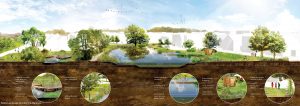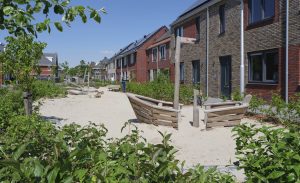
Rijnvliet edible neighborhood
Felixx Landscape Architects & Planners BV show us the project Rijnvliet edible neighborhood, where nature-based solut ions are used to address climate change and provide multiple social, economic and environmental co-benefits.
Rijnvliet Edible Neighborhood (REN) is a new residential area in Utrecht, part of the Leidsche Rijn expansion that provides 1000 new ground-based dwellings.
The project breaks new ground in urban planning by using participatory design to realize an entirely new city district around accessible urban agriculture. Health was placed at the center of city development by weighing all decisions on their impact on citizens’ health.

Section.
Ilustration: Felixx Landscape Architects & Planners BV
Initiated by local residents, the public space in the area is designed as an edible, educative landscape. The layout, based on the principles of food forestry, was developed in a participatory co-design procedure with residents, experts, and the municipality. This has resulted in a public space design where all the greenery is edible for humans or animals.
The initial idea of an urban food forest came from local residents in the neighborhood next to the new urban planning area. The local government embraced the idea and continued interaction with the active citizens during the planning.

Kids picking apples.
Photography: Municipality Utrecht-Dirk Verwoerd
Residents were involved in the design from an early phase through an active participatory process. By making the performative aspects of the public space visible and understandable, users will value its ecosystem services and play an important role in protecting it.
Derived from the strengthened resident engagement, a number of educational, recreational, and (nature) inclusive initiatives were set up. These are evolving initiatives that continuously add new values to the initial design.
The public space of Rijnvliet consists of a 15ha food forest with more than a thousand fruit trees and 220 different subspecies of edible plants, herbs & shrubs. The food forest is built up with multiple layers of plants, forming an integrated ecosystem.

Educational program.
Photography: Felixx Landscape Architects & Plannets BV
The entire district is embedded within a productive landscape, integrating three values: food production, usage, and nature. Therefore, the principles to create a “food forest” are merged with the functionalities required for the surrounding residential areas, providing a multiplicity of uses and unique access to nature for all generations. The abundant green and blue spaces are harmoniously blended with the built environment.
The quality of life is enhanced by providing a rich human experience, high biodiversity, and extensive habitat for birds, bats, and other species. REN uses Nature-based Solutions to address climate change and provide multiple social, economic, and environmental co-benefits.

Tree canopy path.
Photography: Felixx Landscape Architects & Plannets BV
One of the applied solutions is Urban agriculture, which plays an important role in sustainable urban development and helps urban residents to reconnect with nature. The food forest, as a form of urban agriculture, also enhances ecosystem services such as water management, heat reduction, and air purification. It thereby realizes a sustainable urban future for people, animals, and nature altogether.
“REN uses Nature-based Solutions to address climate change and provide multiple social, economic, and environmental co-benefits.”
By involving from the start so many experts from different fields, together with local residents, Rijnvliet was able to become something more than your everyday neighborhood. This multi-angled approach made REN an exceptional project in which a new emerging form of urban agriculture offers enormous opportunities for making our cities more sustainable.

Playground.
Photography: Felixx Landscape Architects & Plannets BV
Contact:
Felixx Landscape Architects: www.felixx.nl











